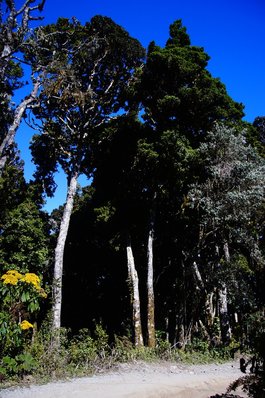 Hiking Volcán Barú, Photo: Alexandra Estévez Hiking Volcán Barú, Photo: Alexandra Estévez We were 100% focused on creating audio walks for traditional historic sites until the Ministry of the Environment approached us with a new request - to create LiveWalks for Panama's National Parks! The combination of human and natural history in the eco-LiveWalks takes the traditional LiveWalk to another level. Our first eco-LiveWalks are for Volcán Barú and Coiba National Parks. The respective LiveWalks are free courtesy of the Ministry of the Environment. We encourage you to download them! We always recommend listening to the audios when you’re on site (it’s just that much cooler!), but perhaps take a peek at home – it may motivate a trip! Why visit Coiba and Volcán Barú? Coiba is a gem of biodiversity. Scientists have yet to identify all of Coiba’s flora and fauna. Take a look at the Smithsonian’s BioBlitz. In addition, scientists are discovering new species endemic to Coiba National Park. Some scientists consider Coiba a Galápagos in the early stages of development. Coiba has retained much of its biodiversity because of its controversial past. For decades, Coiba was home to Panamá’s most feared prison. Panamá’s key role connecting the world began far before the construction of the Canal. The Isthmus of Panamá emerged from the ocean millions of years ago and formed a land bridge that connected North and South America. In Volcán Barú National Park, you will observe flora from the North intermixed with tropical flora from the South. In addition to this fantastic fusion of North and South, the Park has a fascinating human history. The Doraces, an indigenous group that once inhabited this area, vanished mysteriously, leaving behind gold-rich graves that drew the attention of gold-seeking pioneers and archaeologists.
0 Comments
 The oso hormiguero The oso hormiguero One of my favorite aspects of living in Panama City is the proximity to fabulous beaches and forests. Last weekend, my husband, some friends and I hopped in a car and headed to the Plantation Road Trail (about a 28km drive from downtown Panama City). After paying our entrance fee (US$3 for Panamanians, US$5 for foreigners) to the representative from the Ministry of the Environment, we set off on the trail. The path was clearly marked and well defined, yet the towering trees that grew thicker and larger as we progressed made us feel as though we were venturing into the deep jungle. The screeches of monkeys, the joyful calls of birds, and the plethora blue butterflies fluttering along made the experience all the more exciting. A highlight was our encounter with a furry anteater, an “oso hormiguero,” along the trail. Very cool! Several folks were out on the trail for a run or a mountain bike ride but for the most part we felt like we were exploring an area far removed from civilization. The Plantation Road Trail is an easy out and back walk (about 6km each way) and connects to the Camino de Cruces. If you’re planning on hiking the Camino de Cruces it may be worthwhile to hire a guide as we’ve heard the trail is still a bit rough/difficult to follow in areas. Happy Walking! Plantation Road is located off Avenida Omar Torrijos Herrera. Google Map: https://goo.gl/XxCdeU To fully admire the Casco Viejo’s defensive structure and to take a lovely walk while you’re at it, head to the approximately two-mile marine viaduct that encircles the Casco Viejo and forms part of the City’s famous coastal beltway, the Cinta Costera. The marine viaduct opened in April 2014 and has a bike path, walking/jogging path, water fountains, viewing areas, and a plethora of flowers! As you walk, you will enjoy fantastic views of the Casco’s walls (which were so expensive, the Spanish King was rumored to have looked west and expressed his expectation to see the walls from Spain), the mother of pearl laden spires of the Cathedral, and the old military barracks among many other points of interest. The marine viaduct was built primarily to help ease traffic in Panama City but has been quite controversial given that it interrupts the beautiful sea views from the Casco. Residents also feared it would impact the Casco’s World Heritage Site status (thankfully, it didn’t). To learn more about the controversy, see: http://archrecord.construction.com/news/2012/10/121022-Panama-City-Highway-Stirs-Controversy.asp Despite the initial controversy, the Engineering News-Record recently awarded the third phase of the Cinta Costera, which includes the marine viaduct, the 2015 Global Best Project in Roads and Highway Award. For more information, see: http://www.marketwatch.com/story/engineering-news-record-selects-panamas-cinta-costera-3-for-best-road-and-highway-project-honor-2015-08-2 How to get there: If you’re staying in the Casco Viejo, you can easily walk to the entrance. If you're driving, you can park your car in the lot right after the roundabout en route to the Casco Viejo (flagged on the map below). If you take a taxi, you could ask to be dropped off at the Mercado de Mariscos (which is just a short walk away from the start of the viaduct) or at the parking lot indicated below. |
Archives
May 2024
Categories
All
|






 RSS Feed
RSS Feed